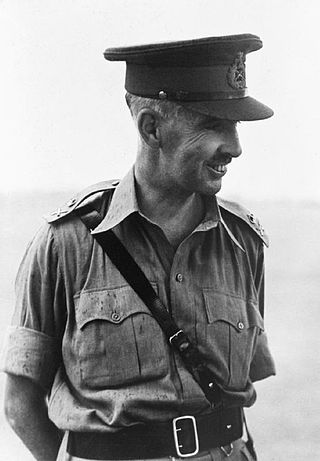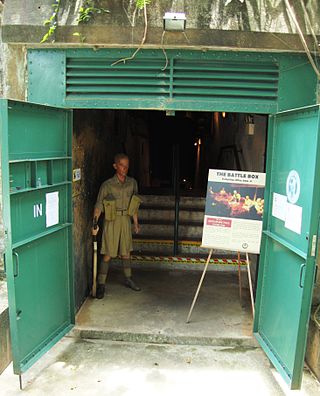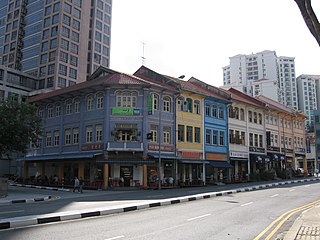
Flagstaff House, built in 1846, is the oldest example of Western-style architecture remaining in Hong Kong. It is located at 10 Cotton Tree Drive, Central – within the Hong Kong Park.
General officer commanding (GOC) is the usual title given in the armies of the United Kingdom and the Commonwealth to a general officer who holds a command appointment.

Lieutenant-General Arthur Ernest Percival, was a British Army officer. He saw service in the First World War and built a successful military career during the interwar period, but is best known for his defeat in the Second World War, when Percival commanded British Commonwealth forces during the Malayan campaign, which culminated in a catastrophic defeat at the Battle of Singapore.
The Far East Command was a British military command which had 2 distinct periods. These were firstly, 18 November 1940 – 7 January 1942 succeeded by the American-British-Dutch-Australian Command (ABDACOM), and secondly, 1963–1971 succeeded by Australia, New Zealand, and United Kingdom Force

The fall of Singapore, also known as the Battle of Singapore, took place in the South–East Asian theatre of the Pacific War. The Japanese Empire captured the British stronghold of Singapore, with fighting lasting from 8 to 15 February 1942. Singapore was the foremost British military base and economic port in South–East Asia and had been of great importance to British interwar defence strategy. The capture of Singapore resulted in the largest British surrender in its history.

The Sun Yat Sen Nanyang Memorial Hall, also known as Wan Qing Yuan, and formerly as the Sun Yat Sen Villa, is a two-story colonial style villa in Balestier, Singapore. The villa is now a museum commemorating Sun Yat Sen (1866–1925), the founding father of the Republic of China who visited Singapore nine times between 1900 and 1911.

A referendum on the terms of integration into the Federation of Malaya was held in Singapore on 1 September 1962. There were three options. At the time of the referendum, Singapore was a self-governing country since 1959, although the British Empire still controlled external relations.

The Battle Box is the popular name of the Fort Canning Bunker, formerly known as Headquarters Malaya Command Operations Bunker, constructed under Fort Canning Hill, Singapore, as an emergency, bomb-proof command centre during the Malayan Campaign and the Battle of Singapore. The Battle Box is currently a museum and tourist attraction.
Major General David Murrey Murray-Lyon, was an officer in the British Indian Army. His final appointment was as the General Officer Commanding (GOC) of the 11th Indian Infantry Division in Malaya until he was relieved of his duty by Lieutenant General Arthur Percival. He was taken prisoner when Singapore fell to the Japanese, and spent the rest of the war in captivity.

River Valley is a planning area located within the Central Area of the Central Region of Singapore. The planning area shares boundaries with Orchard in the north, Museum in the east, Tanglin in the west, and Singapore River in the south.
The Malaya Command was a formation of the British Army formed in the 1920s for the coordination of the defences of British Malaya, which comprised the Straits Settlements, the Federated Malay States and the Unfederated Malay States. It consisted mainly of small garrison forces in Kuala Lumpur, Penang, Taiping, Seremban and Singapore.

The Former Admiralty House is a historic building, located at Old Nelson Road within the Sembawang Planning Area in the North Region of Singapore. The building was used as the administration building of Furen International School (FIS) until November 2019 and is currently being refurbished for use as part of the Sembawang Sports and Community Hub.

The Bukit Batok Memorial is located on top of the tranquil Bukit Batok Hill upon which once stood two war memorials built by Australian POWs to commemorate the war dead of the Japanese and the Allies who fought during the decisive Battle of Bukit Timah in Singapore during the Second World War. The two memorials were destroyed after the war and only the road and stairs that used to lead to them mark its legacy today.

The Battle of Kranji was the second stage of the Empire of Japan's plan for the invasion of Singapore during the Second World War. On 9 February 1942 the Imperial Japanese Army assaulted the north-western front of Singapore, capital of the Straits Settlements.

Lieutenant General Harbaksh Singh, VrC was an Indian senior military officer. As the commander of the Western Command, Singh commanded the Indian Army and played a key role during the Indo-Pakistani War of 1965. For his role in the war, he was awarded the Padma Vibhushan in 1966.

Operation Matador was a military contingency plan of the British Malaya Command to move troops into southern Thailand to counter a Japanese amphibious attack on British Malaya. The plan was never implemented.

Heah Joo Seang was a Malayan politician, business leader, rubber magnate, philanthropist and especially a supporter of education. Malaysia, as it has since become, only existed after Joo Seang's death. His contributions span three distinct periods in the country's history: the British Malaya period, the Malayan Union period, and the Federation of Malaya period.

Tan Kheam Hock was a Singaporean politician and businessman. He was a member of the Municipal Commission of Singapore and several other organisations and a director of various companies.

Bukit Brown Cemetery, also known as the Bukit Brown Municipal Cemetery or the Bukit Brown Chinese Cemetery, was a cemetery in Singapore. It opened in 1922 and acted as a Chinese burial ground until its closure in 1973. Bukit Brown Cemetery is the largest Chinese cemetery outside of China and is also the location of many of Singapore's earliest pioneers.
Inverturret, also known as 7 Gallop Road, is a historic bungalow in the Gallop Extension of the Singapore Botanical Gardens. Previously the residence of the Air Officer Commanding the Far East Air Force and the residence of the French consul-general, the bungalow currently houses the Botanical Art Gallery.















